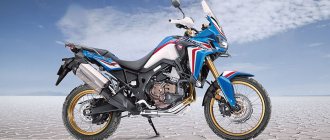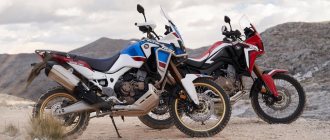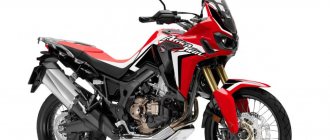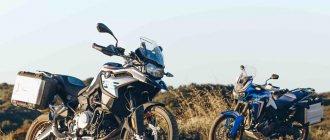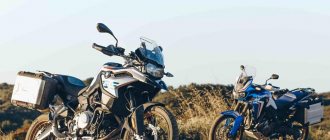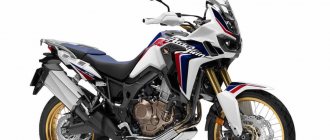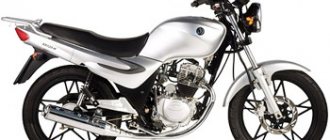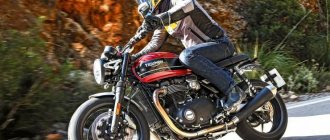Honda Africa Twin 2021
The touring enduro Honda CRF1100L Africa Twin is a flagship on several fronts. Firstly, this is the base platform on which one of the best and most versatile Honda engines to date, a two-cylinder in-line engine with a displacement of 1084 cc, appeared and was tested. Secondly, it is on the Honda Africa Twin that the Honda DCT automatic transmission is being tested - after all, this motorcycle is capable of driving in a variety of modes, with a variety of loads and tasks, from quiet city driving to deserted areas where roads are only heard of. Thirdly, there are excellent suspensions, a durable frame, an excellent power reserve and comfort over long hauls. Fourthly, we should not forget about the on-board electronics - a digital dashboard with wireless communication and extensive functionality and a set of electronic assistants that make this motorcycle convenient and safe even for beginners, despite its impressive size and serious engine displacement. In a word, if the Africa Twin did not exist, it would have been worth inventing it - it almost turned out that way, because this model was renewed quite recently, and its previous version differed from the new one quite radically, including in configuration and displacement, not to mention dozens less significant differences.
What is the flagship in the 2022 version? Today's Honda Africa Twin is an evolution of the previous model, practically no different from it in hardware, but in the light of modern trends, it has a number of software features. However, first things first.
Manufacturer's words
As the manufacturers themselves admitted:
“Despite the fact that after the closure of the XRV 750 Africa Twin we had both the VFR1200X Crosstourer and the XL1000V Varadero, we had nothing to oppose to the Germans with their “goose” BMW R1200GS and the Italians with their Ducati Multistrada. When the British also arrived with the Triumph Tiger Explorer, it became clear that a new Africa was needed like air. We simply shouldn’t miss out on such a fat piece of the pie.”
Production continues.
A Russian user who wishes to receive such a bike needs to stock up on an amount of 700,000 rubles .
Price
For a new device you will have to pay about $17,000, which is not that cheap. But a used version can be found for $10,000 when it’s still new. Older models are difficult to evaluate unambiguously; sometimes owners love their equipment so much that they significantly overestimate its value.
Screenshot 1. Prices for used CRF 1000 Africa Twin
Specifications
From 2022, the model is updated to the second generation, the main difference of which is the increased engine capacity.
The first thing that catches your eye when looking at the new motorcycle is that the Japanese abandoned the V-shaped form factor that the 750 cc .
| Honda CRF1000L Africa Twin (CRF 1000L) | Parameter |
| Engine | Liquid cooled, 4-stroke, 8-valve inline 2-cylinder with 270° camshaft and Uni-cam, 22.5° total forward tilt |
| Engine capacity | 998 cm3 |
| Piston stroke | 92.0 x 75.1mm |
| Maximum power | 70 kW/7500 rpm |
| Maximum torque | 99Nm/6000 rpm. |
| Transmission | Manual transmission: oil bath, multi-disc with springs; Assist Clutch (ASC) Robot: 2 clutches |
| Maximum speed | 199 km/h |
| Cruising speed | 120 km/h |
| Acceleration up to 100 km/h | 3.8 sec |
| Tank | 19 liters |
| Fuel consumption | 3.12 l per 100 km on the road |
| Power reserve | ~ 400 km |
| Dimensions (L x W x H) | 2335 x 930 x 1475 mm |
| Wheelbase | 1575 mm |
| Seat height | 870 mm |
| Ground clearance (ground clearance) distance to the lowest point | 250 mm |
| Curb weight | 230 kg (manual transmission), 240 kg (ROBOT) |
| Turning radius, m | 2.6 m |
The new engine receives an in-line arrangement of pistons . Apart from the overall forward lean of 22.5°, this is a new redesigned 2-cylinder, 4-stroke engine. You don’t even need to mention 270° camber angle
Transmission and clutch
There are also differences in the chassis. The user is offered a choice between a standard 6-speed manual transmission or a robot . The latter also has 6 stages, but its most interesting feature is the presence of 2 (two!!!) clutches .
At the same time, the mechanics have a clutch assist system ( ASC - decoding below). Both options use slip elements.
Despite such a rich filling, the main drive is standard - chain .
Adjustable monoshock absorber.
Chain drive.
Front brakes.
Rear brakes.
Brakes
The changes also affected the brake system. The number of disks is the same as before - 2 disks in the front, 1 in the rear. But the front rotors received a diameter of 310 mm , the rear - 256 mm . The support has also become different - on the front wheel there is a 4-piston Nissin caliper with radial pistons, on the rear wheel there is a 2-piston caliper (from the same company).
ABS is factory installed. A curious detail is a button on the steering wheel that allows you to reconfigure the system with one click depending on what happens to be under the wheels of the motorcycle - the autobahn or a broken rural dirt road .
Engine Honda Africa Twin 2022
The 2021 Honda Africa Twin 1084cc inline-two is one of the best engines ever found in a touring enduro. It's narrow, compact, and has excellent controllable traction from idle to rev. Moreover, even from the bottom, traction is available in abundance, and at high speeds it retains a comfortable and safe character.
Thanks to its compact engine configuration, the 2021 Africa Twin is not too long. This allows you to position the front wheel closer to the engine, make the wheelbase shorter, and thereby provide the motorcycle with a more nimble and controlled geometry on asphalt and off-road.
The 2022 Honda Africa Twin engine is equipped with a unique dual intake tract design with two vertical filter elements. Thanks to this, clean air enters the combustion chambers without restrictions, and the filtration system copes even in conditions of heavy dust.
Unicam's exclusive design keeps the engine cylinder head compact and allows for optimal positioning in the frame while delivering the highest levels of performance. A compact exhaust tract with dual catalytic converters and a valve similar to that used in the Honda CBR1000RR provides low emissions and excellent engine performance. And thanks to the dry-sump lubrication system, the engine has an even more compact design with high ground clearance and reduced vulnerability to impacts.
Honda Africa Twin 2021
Driving performance
The maximum speed indicated in the specification is 199 km/h . The windshield reliably protects the user of average and short height. For particularly tall motorcyclists, it may have to be increased. However, the developers have provided this possibility - the top edge of the glass is smooth.
Acceleration and dynamics
- Acceleration from zero to 100 km/h can “give a light” to other sports - in 3.8 seconds .
- Comfortable cruiser - 120 km/h .
Fuel consumption
Consumption, according to the manufacturer’s documentation, is 3.12 liters per 100 km on the road. It should be noted that these are Japanese indicators (no more than 60 km, number two). In the documents for European models it is 4.62 liters .
Provided that the standard tank is almost 19 liters, the average distance at one gas station is more than 400 km .
What's the choice?
Well, if I had to choose which bike to hop on and go for an evening ride on the enduro track, I would choose the old Africa Twin 1991 RD04. I'm not an oldfag, but the old bike is so light, so willing to ride even outside its comfort zone, that it makes a great companion for fun rides. Well, we must take into account that I love tinkering with old hardware, so fixing a speedometer that failed during a test, starting it with a pusher due to a dead battery and gluing a turn signal hanging on the wires is just as much a thrill for me as driving this thing .
For long trips, my choice is definitely the new Africa Twin 2022. I’m ready to travel hundreds of kilometers with it, explore new routes and destinations, and see new places. Comfort, power and quality of the suspension allow you to focus on the ride and think less about how the motorcycle feels there. In every respect except perhaps weight, the new bike is king: ABS and traction control make it safer and allow you to go faster, the range is longer and the consumption is lower, the engine feels great at highway speeds, and nothing from it during the test didn't fall off.
It's always interesting to ride such an honorable old motorcycle and meticulously examine it in the bright light of the latest technology. In this regard, the 1991 Africa Twin RD04 is nothing to be ashamed of - it may be slower and less refined than new, but anyone who drives it will know that its reputation is well deserved. This is a motorcycle that inspires confidence on and off road, a motorcycle that encourages you to try your hand at yet another goat trail. And this is the bike that will take you home after all your adventures - well, maybe not without a little repair on the side of the road.
With such charisma, you really become attached to it with all your soul to such an extent that you deliberately ignore suspicious puddles under the engine.
Modifications
In parallel with the main basic version, a sports modification of the model is produced.
New for 2022 is the Honda CRF1000L Adventure Sports . Despite the different name, this is a modification of Africa. It is distinguished by longer suspension travel, a fuel tank increased to 24 liters , and an extended windshield. For a separate surcharge, you can get safety bars (with a record of their presence in the vehicle title, which, of course, will upset the traffic police inspectors).
and competitors
- Introduced in 2014 , Honda became a competitor to the Yamaha XTZ1200 Super Tenere, which entered the market in 2010 . However, the engineers of the latter considered that one competitor was not enough, releasing another Yamaha Tenere 700 2017 .
- In the same 2017, Suzuki also had a child. In addition to the V-Strom 1000 , the DL1000 V-Strom XT .
- Kawasaki introduced the Versys 1000.
Africa Twin 2022 amenities
Apple CarPlay
Apple CarPlay is a technology that allows you to integrate your compatible iPhone with your motorcycle controls. This means you can use your iPhone for navigation, music and other services, get weather forecasts, manage playlists and phone calls without taking your hands off the wheel. And wireless headsets will make calls even more convenient.
Android Auto
Similar functionality, compatible with Android smartphones, is provided by the Android Auto service. Hints from the navigator, managing calls and messages and much more without taking your phone out of your pocket - what could be more convenient when traveling?
LCD display
The 6.5-inch color touchscreen display has three layout options, displaying different amounts of information about the operation and parameters of the motorcycle, as well as navigator tips and other information from Apple CarPlay and Android Auto services.
Update from smartphone
Updating the dashboard firmware allows you to correct errors in its operation and expand its functionality. It was through a firmware update that Africa Twin received Android Auto support. You can easily and conveniently update the dashboard software using your smartphone.
Manual transmission
The base version of the 2022 Africa Twin is equipped with a traditional six-speed manual transmission with a clutch lever - a reliable, proven design that is also somewhat lighter.
Luggage capacity
The optional aluminum panniers are sure to become your favorite accessory. All three cases are equipped with waterproof inserts, and the top one can easily accommodate a full-face helmet. In addition, all three cases are locked with one key.
Gas tank
The base Africa Twin and Africa Twin DCT have an 18.8-litre tank, while both Adventure Sports ES versions have a 24-litre tank, enough for an XL travel size.
Honda Africa Twin 2021
Peculiarities
The ability to adjust the seat height makes the motorcycle comfortable for both tall riders and shorter riders.
Since at the last motorcycle show Honda announced the start of work on Africa for the new 2022 model year, this section is divided into 2 parts. And the first is what already assembled bikes can boast of.
This:
- RbW (Ride-by-Wire system) - electronically controlled throttles.
- ABS , complemented by the ability to switch depending on the track.
- ASC (Assist and Slipper clutch) - assistance when working with the clutch.
- HSTC (Honda Selectable Torque Control) - traction control.
The second part contains what is expected in the new version as an addition to what is already installed. It should be noted that all the features described below will be optional, with the exception of the first:
- ABS , complemented by the ability to switch over a wider range ( Onroad/Offroad ).
- DRL (Daytime Running Lights) - daytime running lights.
- Control of turn signals - a couple of seconds after the maneuver, the motorcycle can turn off the light itself. The Adventure Sports modification also promises automatic activation before a maneuver.
- Heated steering wheel grips - no comment.
- Cruise control - the ability to electronically support a given speed.
The section specifically does not include any data such as excellent maneuverability, excellent handling and driving performance . After all, this is an Africa Twin - it simply cannot be otherwise.
Greetings, dear comrades. I’ve been thinking for a long time about writing a post about my first, Japanese motorcycle. Everyone somehow didn’t get around to it. Now I’m sick, I have time). I ask everyone under KAT) ACHTUNG! MANY LETTERS!) GENERAL CONCLUSION AT THE END!)
Prehistory
I’ll tell you a little about myself: I’m 30, height 192, weight 100, quite a big guy, also bearded). I live in Ukraine, in a small town with very bad roads. Education: Engineer-researcher of machines and mechanisms. Technology has been close to me since childhood; I really love motorcycles and motor vehicles. Ural-Dnieprovod lvl 100. (There will be a separate post about my latest work in the Urals) Hobby: repair and restoration of motorcycles. I love working with old technology. The older the year, the more interesting it is. You can trace all the technologies and engineering solutions of that time. In general, you understand)
No matter how much I love Soviet technology, it cannot be compared with Japanese technology and has much lower, structural safety margins. I wanted a motorcycle that would carry me every day and give me joy. Ural for the soul, Japanese for driving, so I thought. Unfortunately, there wasn’t a lot of money to buy a Japanese car; huge budgets at that time were drained into the Urals. You could buy a good Japanese one.
First choice:
A few years before buying my first Japanese car, my brother bought himself a 2001 Yamaha Drag Star 400 Classic. I rode it, I liked it, the appearance is absolutely bomb. CARDAN!.. Cobra exhaust - your ears are touched. At heart I am more inclined towards cruisers. Several years have passed. The bro switched to higher-class motorcycles. Of course, I rode everyone and there was some understanding. After collecting some money (the Urals are eating like a bottomless pit), it was decided to go for the long-desired Drazhechka. I had already trained the motorcycle, read the manual, and knew what went where. I waited for winter, falling prices and counted the days until the long-awaited purchase.
My good friend Semyon at that time bought himself a 1989 Honda TransAlp XL 600V.
I didn't understand that motorcycle. Appearance compared to a cruiser is so-so, chain drive, years old. In general, I have definitely decided that I will take the Yamaha Drag Star 400 Classic. Purely by chance, I don’t know how, I took the transic for a ride. Probably for a general understanding of what Tour-Enduro is, I don’t remember anymore. Here’s an old man: “DEAR MOTHER! WHAT IS THIS? WHERE THE PITS ARE I DON’T UNDERSTAND!” — first thoughts from the first couple of tens of kilometers around the city.
I rode all evening, pits, speed bumps, curbs, edges, railway crossings - the suspension is gorgeous, it’s more comfortable to sit than on the Dredge (my knees are high on the drag, when I turn the steering wheel it rests on my knees, I can’t do a full turn, I have to remove my knees) but I would like it to be a little higher, so that the knee is not so sharply bent. It was a fateful evening). (Thank you Semyon). I spent a few weeks debating whether it would be a Cruiser or a Tour-Enduro. By that time I was approaching 30. And common sense prevailed, although the eyes and heart wanted a cruiser. I compared all the pros and cons. Features of the area where I live and will operate the motorcycle, year, wheel drive, suspension, manufacturability, versatility, reliability, problems and sores, engine cubic capacity, conditions and reviews of people. I read the forums. I studied the design of Darga and Transik from the manuals. I tried to draw an objective conclusion.
Solved: only 1 motorcycle meets all my criteria: Honda Africa Twin Adventure Sports XRV750. I am studying all the information on it, including the manual for service technicians, which describes all the detailed types of maintenance and repairs. I look at the prices for original spare parts, as well as maintaining the Urals) (figuratively, of course, some are more expensive, some are cheaper)
I study the entire model range of Africa, the stages of their evolution. For enlightenment: there were RD-03 from 1988 until 1990, from 1990 to 1993 there were RD04 with various letter indices (L,M,N and so on), after RD-07 until 1996 and RD-07A until 2000 it seems ( there are inaccuracies) Each year had its own color scheme, only this one and no other. When choosing a motorcycle on trading platforms, I saw that most of the motorcycles were very tired, repainted, and so on. The color scheme does not correspond to the year and other technical issues such as the winding runs, and the descriptions that people write. Unfortunately, all sellers, well, most, are liars, to put it mildly. The declared mileage is 40 thousand, for example, according to the description, he repaired something that should have broken down at about 100-150k km. Let’s not go deeper, you know better without me.
Based on all the design features and my budget, I chose the 1990 Honda Africa Twin Adventure Sports XRV750 RD04 L.
This is a reference sample. It should be like this with all the original components.
For some reason, on later models RD07 and beyond, some of the “goodies” were removed. For example: -2 fuel sensors on RD04 and complete absence on 07x models. -24 (1 more can fit) liter tank, 2 taps on RD04 and 23 liters (probably 1 more can fit) 1 tap on 07x models -fork with pneumatic inflation on RD04, was also on 07x but until some year. Then they refused. -higher stance on the RD04 model - just right for me -slightly longer rear swingarm from the 07th model.
Don't think badly of the 07 model. She also had other differences for the better, of course. But the price tag there started at 2-3k green higher.
Other design features of Africa: - 3 valves per cylinder - 2 spark plugs per cylinder - cubic capacity of the engine - Rear and front disc brakes - 3 cooling radiators (2 liquid, 1 oil) From an engineering point of view, this complicates the design, adds a unit such as a pump, which most likely it will be necessary to change the assembly, but there is an undeniable number of advantages of the “dropsy” as opposed to the “air vent” - high ground clearance - Of course, a chic, progressive suspension with the ability to adjust the shock absorber (a separate cylinder is installed as standard) and spring preload - landing - tachometer - excellent reviews from owners and huge long-distance runs. — The engine, with timely and proper maintenance, runs up to 300k km. (different sources say differently and depends on many factors, of course) - Imagine all this in 1990. All these "goodies". In my opinion, assessing a motorcycle that is 28 years old by modern standards in 2022 is a little incorrect. — maybe I missed something else, I’m sick)
"D-DAY"
After calling the seller, we went to Kyiv for inspection. I even recorded a video) In real life, of course, the motorcycle was so-so. Lots of scratches, chips, non-original components. But I knew that I was going to look and buy, and it is of course not logical to expect an ideal from a motorcycle from 1990 (28 years old moped! almost like me). I checked all the components that interested me in the first place, what can I say, the motorcycle required maintenance, the price tag was appropriate, and unfortunately there wasn’t much choice. The only copy (on the market) that is almost in original condition. The declared mileage is 85k km (I’ll boldly throw in 100k and treat it like a motorcycle with 200k mileage, roughly speaking. The secondary shaft is normal: 650 km of road and we’re home.
Ownership experience and general feeling.
I rode it as is for a couple of months and then went to winter quarters. Dedicated points for maintenance and repair: - of course, oil change. I filled it with Motul 7100 and am testing it. I don’t have any particular love for any brand, I just have feelings, so to speak. — oil filter. Hiflo 303 as standard. — Gasoline filter — Replacement of all brake fluid — Replacement of the coolant — replacement of front and rear tires — change of oil in the fork — replacement of spark plugs — repair of rear turns (broken) — purchase of original front turns (there are some Chinese ones) — the right mirror is not original, purchase The original one (on RD04 and RD07 in Africa they are different) 04 has a rubber silent block to reduce vibration in the mirrors, 07 no longer has it. — installation of high touring glass — soldering of plastic (almost all of it was intact) — cleaning, washing, alignment of all radiators — repair of fuel sensors (didn’t work, was in the know) — purchase and installation of original rear disc protection (there was none) — weld and paint the muffler (there was a small hole) - replacing the original washer with the sprocket and 2 new, original bolts for it - replacing the fork corrugations (scary, still original)
I fell asleep something like this:
There’s already a lot of text, but I haven’t told you everything yet).
Let's briefly go over the work: There was a dirty radiator with crumpled honeycombs: The left radiator was crushed by the previous owner: Using tweezers and a needle, I cleaned and aligned the honeycombs of all radiators, blew them out with a compressor: The radiators have protection, but the holes in it are large: Flies and other living creatures flies, I made a new protection from a fine mesh, budget-friendly and extremely effective, I recommend it for all your mopeds: I put a fine mesh under the bottom of the original mesh: The radiators are always clean, the honeycombs are intact and not jammed. The motorcycle has normal cooling. I've been using this in my car for 11 years. I close the lower oil cooler in the same way. The rear turns were like this)): Here's a life hack for fixing them: (who has the same turns and who doesn't know) We disassemble the broken turn, insert an iron tube inside, connect the 2 parts of the leg (they dry out over time), wrap it with electrical tape (necessarily blue, it has the healing power of the earth :-)), put several layers of heat shrink on top and voila.
The rigidity is restored, the corners can perform their function normally and have a better appearance. Of course, in the future I would like to buy new original twists, but for now they are 50 bucks apiece, so far. The front corners were generally not original, at a disassembly I bought a couple of used original corners, the lenses were branded as Stanley and were successfully installed: In the photo, a high touring glass has already been installed: And the fork corrugations were replaced: The rubber was also replaced. Rear Michelin Anaki 2, front Michelin model I don’t remember. My cat is waiting for the fuel sensors to be repaired and doesn’t want to leave: Next, I bought a protective cover for the rear shock absorber. The shock absorber is open, and abrasive from the wheel flies at it, thereby sandblasting the shock absorber rod. Here it is: The original muffler is welded and painted. By the way, it’s written in the manual, I’m sure you don’t know. May also apply to other motorcycles. “We strongly do not recommend replacing the original muffler as it acts as a safety bar in the event of a fall.” I just know a lot of people who replace the original mufflers on their motorcycles with lighter, more beautiful-sounding ones. Fireproof paint, of course. Tested for a season, there is no smell or breakage. At the beginning of the season I already got the following result: I successfully skated an entire season on it. I went with friends to a long distance trip, if anyone is interested, please see there is a description and a video) Afterwards, my wife and I went to Uman. 800 km of the most “wonderful” roads in Ukraine. We visited the arboretum. The video needs to be edited)
General conclusion and impressions of the motorcycle and its ownership
When buying one, as my fellow “necro-Japanese” says, be prepared for normal motorcycle maintenance. Not like most, everything is limited to changing the oil and that’s it. I highly recommend reading the manuals. Be prepared for the fact that no one has climbed there before you or performed maintenance in a timely manner. Brake hoses are supposed to be changed every 2 years (in Africa, I don’t know about others) EVERY 2 YEARS CARL! I also think this is news for most). Wheel bearings, steering wheels, brake caliper maintenance, and any motorcycle has a ton of maintenance. Nobody reads. And everyone has had them since the motorcycle left the factory, and they haven’t been touched there since.
The motorcycle is not whimsical, it forgives a lot of collective farming, many spare parts are unified with other models. Durable, the pendants are gorgeous. The engine is a bit lacking on the highway. I would like a liter, purely for overtaking. For me it’s comfortable to drive 90-100 (for me, I like a calm, measured ride without the violence of technology). Fuel consumption is 5 liters on the highway. Over the hill in Polyandia it turned out to be 4.7 (either I didn’t top it up, or the fuel is really better, although I don’t think I topped it up). Cruising range 420 km before dry tank. 2 fuel sensors, they operate at 8.2 liters in the tank, the other at 4.2 liters. The air filter is serviceable. The weak point is the original fuel pump, I bought it with a new one (and it breaks down at about 50k mileage). There are vacuum ones, install them and ride them. Reading that people are yelling “my fuel pump broke on the highway.” To fix it, you just need to clean the contacts that have been burnt there all the time. And so that it doesn’t break down on the highway, before the trip, look at all the weak points of the motorcycle, service it and move on. Having endured tons of breakdowns and repairs in the Urals, it just becomes funny to me that people call it “broken.” It broke down when the cylinder fell off while you were away from home. When the crankshaft decided to abandon you and throw you off the engine onto the road, remaining somewhere behind and free. When your piston pierced the doors of a car driving next to you, and so on in short.
Writing in the city is crowded. I live in a city with a population of 100k people. There is not enough transport, I want to throw up 30 in the city, I want 50, I don’t bother anyone. We don't have any traffic jams. So it depends on what city. I rode in regional cities, the steering wheel goes higher than the car mirrors, the bike is narrow, there are no side panniers, quite good. I would like the brakes to be better, I hope replacing them with armored hoses will partially solve the problem. The single-piston rear brake is rather weak. The low beam is so-so, I would like it to be better, I think I can solve it with adequate additional light. High center of gravity, requires a certain type of rider. The seating position is comfortable for me, I can fidget back and forth on the seat. The front fork is a bit soft and has a bit of a dive when braking. It can be solved by replacing the springs with progressive ones and adjusting the oil viscosity. I haven’t tried it off-road, I don’t like it, I can drive on dirt roads and paths, everything is fine. There is no desire to frankly get involved in takara and other events to kill motor vehicles.
I bought it as a universal motorcycle for bad roads, light off-road and long-distance trips. People have owned African cars for 8-10 years in groups of African drivers, the mileage is 100-150 thousand, only they do not take into account what was already on the odometer. There is not much to change. You can judge for yourself what is sold on the market with mileages of 50-70k, it’s funny to even read. “I bought it from my grandfather, he kept it for his grandson, but he didn’t want it, because the motorcycle is old and the mileage is so low.” - almost all the people I know.
If in your understanding a good motorcycle is “sit down, get to the point, get up, the time has come, give it to the service station without looking at what’s there, pick it up and ride from point to point again” - it’s not for you. Maintain it properly. Find someone who will serve you conscientiously and competently, and he will serve you for a long time. Africa has a lot of resources. Not like new cars and motorcycles. Of course, it depends on the condition in which you buy it. I tried to describe everything without a biased attitude like “every frog praises its swamp” and to be objective.
My total mileage on the motorcycle is 10k km so far. There have been no breakdowns yet. Plans to additionally service it according to the manual using original spare parts and restore it to its original form. Ride long distance rides with friends and share with you).
In conclusion I will say this. Gentlemen, love your motorcycles, maintain them correctly and be healthy.
TO SET THE MOOD
(otherwise I smell trouble here) here are photos of my beloved wife and moped):
Thank you for your attention and patience in completing this post)
Chassis and brakes
The frame is made of steel. Its contours impress with elegance and strength. There is something in the appearance of a motorcycle that declares its undeniable power and reliability. The colors are perfectly chosen. The wheels are spoked. The steering wheel is a convenient and reliable control tool.
The rear suspension has a travel of 214 mm; it is a pendulum version with a monoshock absorber. The front suspension is a telescopic fork with a size of 43 mm and a stroke of 220 mm. The rear brake is a 256 mm disc with a single-piston caliper. At the front there are two discs, each measuring 276 mm, and the caliper is two-piston.
Maintenance and repair
Although it’s difficult to call this motorcycle gentle, it still requires attention. If we are talking about ordinary maintenance, then it is worth paying attention to the chain, since when using a motorcycle for its intended purpose, it will have to be cleaned much more often than on motorcycles that live on asphalt. As for the rest of the consumables, a simple motorcycle algorithm applies here - be prepared to replace consumables frequently.
Regarding the repair, here Honda reinforced the stereotype about the reliability of its equipment; the motorcycle really turned out to be durable. But nothing lasts forever, and if an incident occurs, then the experts will help you fix it. Fortunately, Hondas undertake repairs with ease.
